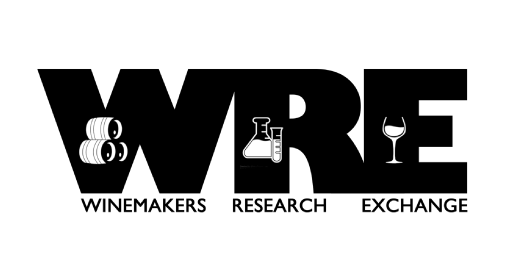Comparison of wine quality from Cabernet Franc Clones 312 (FPS 13) and 327
Nate Walsh and Ben Sedlins
Walsh Family Wine
Summary
Cabernet Franc is the dominant red wine grape planted in Virginia. Several clones have been characterized for this variety, but none have been characterized specifically for Virginia. In this study, two clones of Cabernet Franc (312 and 327) planted in the same vineyard were made with identical winemaking. Fruit from clone 312 was harvested with 0.9°Brix higher than fruit from clone 327, and required 2 g/L more tartaric acid to maintain the same pH in the finished wine. All other general chemistry parameters and phenolic measurements were the same between clones. There were no perceptible differences between the wines in a triangle test nor in descriptive scores for aromatic intensity, color, fruit intensity, structure/astringency, or herbaceous/green character.
Introduction
Cabernet Franc has been grown in France for centuries, with the oldest recorded mention of the variety Breton (a synonym for Cabernet Frac) in 1534 in the Loire Valley1 and as early as the 18th century in Bordeaux2. The variety is so old, it is thought to be “undoubtedly one of the most important and ancient varieties in the Bordeaux region”1. Its importance in Bordeaux lies more in its progeny than its dominance as a variety, having parented Merlot (with Magdeleine Noir des Charente), Cabernet Sauvignon (with Sauvignon Blanc) and Carménère (with Gros Cabernet)1.
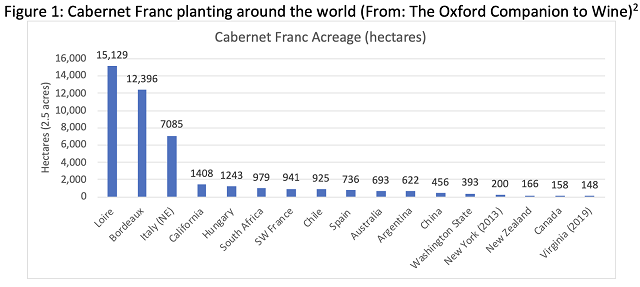
Cab Franc is currently one of 20-most planted wine grape varieties in the world2 and can be found on several continents in many growing regions (Figure 1). Cabernet Franc ripens earlier than Cabernet Sauvignon1, which allows it to hedge against poor weather late in the season in Bordeaux, where it is primarily used in blends, and makes it particularly well suited to the cool inland climate of the Loire, where it is often bottled on its own. In Virginia, Cabernet Franc competes with Chardonnay for supremacy in acres planted and tons produced each year (Figure 2) and is decidedly the most common red wine, made both as varietal wine and used widely in red blends3.
Figure 2: 5-year trend in Cab Franc planting (From: 2019 Virginia Commercial Grape Report)3
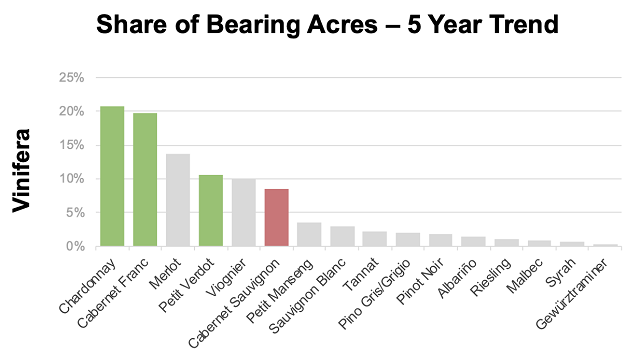
In the vineyard, Cabernet Franc has several qualities that make it well suited for Virginia. It is somewhat more cold hardy than Cabernet Sauvignon, and buds and matures sooner, a good thing in years with spring frost or late season rain1,4. It is well suited to clay/limestone soils1 and has small berries and thick skins which give this variety good resistance to fruit rots and splitting1,4. It can have high bud fertility leading to overcropping and poor fruit quality and can be excessively vigorous in high fertility soils4, so care must be taken to prune and hedge properly.
As a variety, Cabernet Franc has the potential to produce methoxypyrazine which leads to herbaceous sensory qualities. Pyrazine is produced by two pathways, one that depends on environmental factors such as grape maturity, climate and fruit exposure, and one that does not5. The variety can produce up to 35 ng/L of methoxypyrazine while the detection level is 15 ng/L in red wines6. Much of Cabernet Franc farming focuses on managing crop level, sun exposure, and vegetative growth to limit methoxypyrazine production. This could also be a concern with different genetic stock (clones).
Within the variety, there are several known clones of Cabernet Franc. UC Davis’s Foundation plant services website, which catalogues varieties and clones that have been cultivated and certified through grapevine breeding program, list 19 different clones for Cab Franc7 and there are 30 clones characterized on the ENTAV website8. A clone (also known as a cultivar) is a single genetic expression, created by propagation from a single mother vine that was carefully selected for specific traits such as cold hardiness, disease resistance, or quality of juice 9. In modern times, cuttings from a single vine are grafted to rootstock, which may further impact the genetic expression of the clone. Though clones are usually characterized at their place of origin, they may behave differently in different climates and when grafted to different rootstocks. A few studies have been done comparing clones of Cabernet Franc in different environments10, however these often yield inconsistent results. The purpose of this study was to characterize the chemical and sensory qualities of wine produced from two different Cabernet Franc clones at Walsh Family Wine. Clone 327 is an ENTAV clone and has been characterized in France as having low weight clusters, medium sized berries, high total acidity, medium high potential for color and tannic structure, with the potential to produce rich and structured wines8. Clone 312 (aka FPS 13) originated from a generic French clone, and no clonal information is readily available through Davis or ENTAV.
Methods
The experiment was conducted at Walsh Family Vineyard, near Leesburg, Virginia, in a 2.34 acre block of Cabernet Franc. The vineyard block was established in 2016. Cabernet Franc was planted to clones 327 and 312 on Riparia rootstock. The vineyard design is 7.5 ft by 3.75 ft spacing on a VSP trellis, and the vines are trained to a unilateral cordon. The site is situated at 570 to 640-ft above sea level, on a 10-15 degree slope oriented east, northeast. The Cabernet Franc is soil-mapped by geovine.com as Catoctin channery silt loam.
Grapes from each clone were harvested separately on the same day and wine was made with identical winemaking according to the standard protocols of the winery. Fruit was destemmed with addition of 35 ppm SO2. Fruit was cold soaked for three days, covered with dry ice. Bins were warmed, then fermentation was inoculated with 15 g/hL BDX yeast rehydrated in 30 g/hL GoFerm. Tartaric acid (1 g/hL) was added at the end of cold soak. Fermentation was monitored daily for Brix and temperature with a target temperature around 80°F. Bins received two punchdowns daily. Fermaid K (12 g/hL) and DAP (12 g/hL) were added at the end of lag phase. An additional 1 g/hL tartaric acid was added at the end of fermentation. Clone 312 received an additional 2 g/hL tartaric acid mid-fermentation based on monitoring of pH during fermentation.
Malolactic fermentation was inoculated at 5°Brix using 1 g/hL MBR31. Bins were drained/pressed on the same day after extended maceration of 5-10 days. Both bins received the same number of days total from picking to pressing. Wine was monitored for malic acid depletion using paper chromatography. Sulfur dioxide (50 ppm) was added at the completion of ML. An additional 50 ppm was added after 30 days.
Sensory analysis was completed by a panel of 26 wine producers. Wines were presented blind in randomly numbered glasses. Tasters were presented with three wines, two of one type and one of another, and asked to identify which wine was different (a triangle test). There were three tasting groups with the unique wine in the triangle test balanced between groups. Tasters were then asked to score each wine on a scale of 0 to 10 for aromatic intensity, color, fruit intensity, structure (astringency) and herbaceous/green character. They were also given open ended questions to describe the wines. Results for the triangle test were analyzed using a one-tailed Z test. Descriptive scores were analyzed using repeated measures ANOVA.
Results
Clone 312 produced heavier clusters with higher Brix and pH (Table 1). pH monitoring throughout fermentation showed that wine from clone 312 rose in pH faster than wine from clone 327 (Table 2). Two additional grams per liter of tartaric acid were added to maintain a similar pH. This indicates there may be more potassium in the grapes from clone 312. Final wine chemistry was very similar (Table 3). Clone 312 produced wine with higher color intensity than Clone 327 (Table 4), however, this difference was not perceptible in sensory analysis (Table 7). There was little difference in anthocyanin or phenolic measures between clones (Tables 5&6) and no perceptible difference in astringency/structure (Table 7). In a triangle test of wines made from clones 312 and 327, 12 out of 26 respondents were able to distinguish which wine was different, indicating the wines were not significantly different (Z= 1.178, p= 0.12). There were no significant differences in scores for aromatic intensity, color, fruit intensity, structure (astringency) or herbaceous/green character (Table 7).
Table 1: Fruit metrics for two clones of Cabernet Franc (in-house data)

Figure 3: Fermentation kinetics for two clones of Cabernet Franc (in-house data)
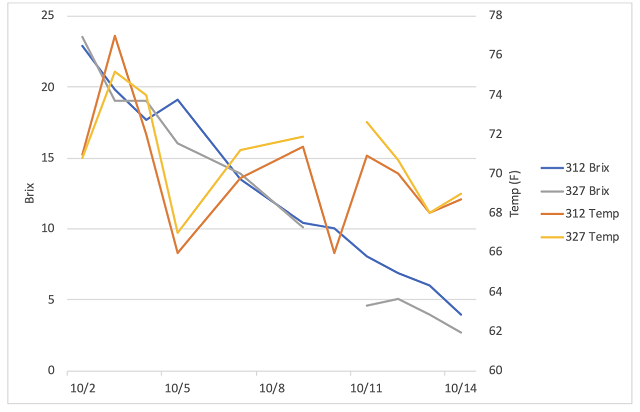
Table 2: Changes in pH and acid additions during fermentation for two clones of Cabernet Franc (in-house data)
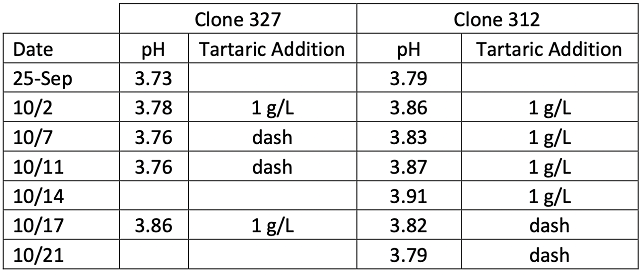
Table 3: Wine chemistry for two clones of Cabernet Franc (ICV Labs)

Table 4: Color metrics for two clones of Cabernet Franc (ICV Labs)

Table 5: Anthocyanins for two clones of Cabernet Franc (mg/L)(ETS labs)

Table 6: Phenolics for two clones of Cabernet Franc (mg/L)(ETS labs)

Table 7: Descriptive scores and repeated measures ANOVA statistics for two clones of Cab Franc (WRE)

References
(1) Robinson, J.; Harding, J.; Vouillamoz, J. Wine Grapes: A Complete Guide to 1368 Vine Varieties, Including Their Origins and Flavours, Illustrated Edition.; The Penguin Group: New York, 2012.
(2) Robinson, J. The Oxford Companion to Wine, Third Editioin.; Oxford University Press: Oxford, 2006.
(3) SMS Research Advisors. 2019 Virginia Commercial Grape Report. 2020.
(4) Wolf, T. K. Wine Grape Production Guide for Eastern North America; Plant and Life Sciences Publishing: Ithaca, New York, 2008.
(5) Zoecklein, B. W. Herbaceous Character in Red Wines. Virginia Tech Enology Notes, 2004.
(6) Zoecklein, B. W. Herbaceous Character in Red Wines. Enology Notes, 2006.
(7) Grape Variety: Cabernet Franc. Foundation Plant Services Grapes.
(8) Cabernet Franc N. Pl@nt Grape: Catalogue of grapevines in France.
(9) Wilcox, K. Winemakers Still Fighting the Clone Wars. Wine Searcher. September 12, 2020.
(10) Dimovska, V.; Beleski, K.; Ivanova, V.; Boskov, K.; Ilieva, F. Agro-Biological and Technological Characteristics of Four Cabernet Franc (Vitis Vinifera L.) Clones Grown in Republic of Macedonia. 5.
